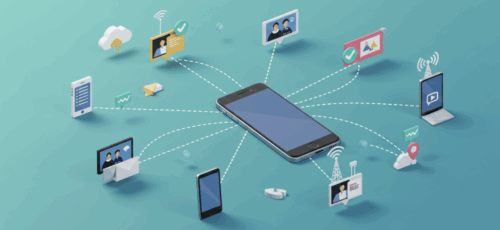SMS text messages continue to be one of the most immediate and effective tools for customer engagement, powering everything from appointment reminders and two-factor authentication to feedback surveys and marketing campaigns.
For developers building out messaging workflows or integrating communications into platforms, understanding SMS pricing for business is critical. Without a flexible model that aligns with usage patterns, even the most strategic implementations of SMS marketing can run into scalability and budget constraints.
This guide breaks down how SMS marketing pricing works, why it’s essential to evaluate both flat-rate and pay-as-you-go models, and how to choose a provider that enables scale without locking you into long-term contracts. Whether you’re sending transactional notifications or launching high-volume campaigns, a customizable SMS service helps you control spend, improve deliverability, and build more reliable communications into your software or systems.
Texting: Practical Use Cases and Smart SMS Pricing for Business Strategies
From internal alerts to customer outreach, texting has become a core tool for modern communication. Understanding how businesses use SMS and aligning that usage with the right pricing model is key to optimizing both performance and cost.
How Businesses Are Using SMS to Streamline Communication
Organizations use texting to simplify and accelerate everyday interactions. Common use cases include internal team updates, appointment reminders, customer feedback requests, order confirmations, and two-factor authentication. SMS enables fast, frictionless communication without relying on app installs or email opens, making it one of the most popular services for real-time engagement.
Custom Plans for Matching Your Messaging Strategy to the Right Pricing Model
Choosing a pricing structure that supports your specific use case, whether high-volume marketing or transactional alerts, is essential for long-term efficiency. Without a custom plan that accounts for message volume, inbound SMS behavior, and potential carrier fees, businesses risk overspending or underutilizing their SMS service. Opting for a pay-as-you-go model often minimizes setup fees and offers flexibility as messaging needs evolve.
Business Messaging vs. Consumer SMS: What Developers Need to Know
While standard person-to-person texting works for casual communication, business messaging requires a more robust infrastructure.
Most SMS text messages between consumers fall under person-to-person (P2P) traffic, which isn’t designed to handle automation or high volume. For business use, especially when sending outbound messages from an app or workflow, a shift to application-to-person (A2P) SMS is necessary.
A2P supports bulk messaging, marketing campaigns, and triggered alerts but is subject to carrier regulations and registration requirements. Using the wrong traffic type can lead to carrier fees or deliverability issues. A platform that supports compliant A2P traffic helps ensure your SMS pricing aligns with both usage and reliability standards.
Why SMS Is a Smart, Scalable Addition to Any Communication Stack
Business messaging delivers more than just quick interactions. It enables smarter, automated communication flows that scale with demand and integrate easily into your existing tools.
Drive Engagement Through Direct, High-Response Messaging
SMS consistently outperforms email and other channels in open and response rates, making it one of the most effective tools for customer engagement. Whether you’re building marketing pricing workflows, feedback surveys, or post-purchase follow-ups, SMS text messages deliver near-instant visibility and response. With support for inbound SMS, developers can create seamless two-way conversations that improve retention and capture real-time insights.
Unlock Additional Features with Minimal Code
Modern APIs make it easy to embed advanced messaging capabilities into your app, CRM, or customer portal. You can programmatically enable appointment reminders, two-factor authentication, SMS masking, and more without dealing with bulky setup fees or telecom complexity. By using a carrier-grade platform, you can send messages through long code or toll-free numbers and access additional features like real-time delivery receipts and number provisioning.
Flexible, Cost-Efficient Communication at Scale
With a pay-as-you-go pricing model and no long-term contracts, developers can build, test, and deploy without incurring unnecessary overhead. This structure supports businesses with seasonal spikes or variable usage and eliminates waste tied to unused credits or rigid monthly plans. For teams integrating messaging into larger systems, that means more control, fewer carrier fees, and easier budget alignment from the start.
Comparing SMS Pricing Models and Their Impact on Business Performance
Your pricing model affects your messaging costs while shaping how your systems scale, how you manage resources, and how quickly you can adapt to change. For developers building communication into business platforms, understanding pricing structures is critical to designing an efficient solution.
Flat-Rate Plans: Predictable Billing With Limited Flexibility
Flat-rate pricing offers a set number of messages per billing cycle at a fixed cost. While it simplifies budgeting, this model assumes consistent traffic volume. If your app or workflow sends more messages than your plan allows, it can trigger additional carrier fees or service disruptions. Conversely, underutilization means you’re paying for unused messages, which creates an inefficient tradeoff for startups, seasonal businesses, or apps with fluctuating engagement.
Flat-rate plans may also come with setup fees or long-term contracts that limit flexibility. For dev teams seeking to test and iterate, this structure can feel overly rigid.
Pay-as-You-Go: Flexible Pricing That Scales With You
A pay-as-you-go (or metered) model charges only for messages sent and received, allowing your usage to scale up or down as needed. This is ideal for developers building messaging into products with variable traffic like event-based campaigns, limited-time offers, or apps that grow quickly. There are no wasted credits or artificial limits. You get true cost alignment and can build a custom plan tailored to your usage patterns.
This approach is especially well-suited to cloud-based services, where infrastructure doesn’t need to be reconfigured for changes in traffic. You avoid setup fees, reduce risk, and retain control over costs, whether you’re managing thousands of inbound SMS alerts or sending outbound messages to users during a launch.
Choosing the Right Model for Your Messaging Workflow
When evaluating SMS marketing pricing, your decision should reflect how your platform functions. If you expect consistent, high-volume messaging with limited variation, a flat-rate model might offer savings. But if you’re supporting multiple clients, running staggered campaigns, or scaling usage dynamically, a pay-as-you-go model provides the elasticity you need.
Integrating SMS into your tech stack is a long-term architectural choice. Choosing the wrong model can lock you into hidden monthly fees, inconsistent delivery, or constrained growth. The right model supports performance, cost-efficiency, and user experience without compromise.
Matching Your SMS Pricing Model to Business Needs
Different messaging strategies call for different pricing structures. Choosing the right model depends on your client’s volume, growth trajectory, and how they use SMS within their operations.
Here’s a quick breakdown of when each model makes sense:
- Pay as You Go (Metered Pricing)
Ideal for startups, SaaS products, and teams building flexible workflows- Only pay for messages sent and received
- No setup fees or unused credits
- Scales easily for seasonal spikes or user growth
- Enables agile testing and development with minimal overhead
- Flat-Rate Pricing
Better suited for high-volume, stable usage- Fixed monthly cost with predefined message limits
- Predictable billing for mature businesses with steady outbound messages
- May incur carrier fees or service issues during volume spikes
- Can include extra fees for additional messages beyond the limit
For most developers building messaging into modern applications, a pay-as-you-go model offers the control and elasticity needed to align with real-world usage and avoid overpaying.
Key Factors That Impact SMS Pricing and Platform Value
Choosing a provider is about identifying the platform that aligns with your architecture, growth plans, and client expectations. The right SMS service should provide reliability, scalability, and the additional features you need to build and maintain messaging at scale.
Whether you’re launching a new product or integrating SMS text messages into an existing system, consider how each provider handles uptime, flexibility, inbound SMS volume, and the availability of custom plans. These factors directly influence your platform’s performance, messaging deliverability, and total cost of ownership over time.
Reliability That Supports Mission-Critical Messaging
When choosing an SMS platform, determine if the provider offers the reliability your business or client needs. Most apps and systems with text messaging will require 24/7 uptime. For instance, if a banking customer tries to log in to their bank account outside of normal business hours, they would expect to quickly receive a 2FA text message regardless of the time.
A reliable provider will also avoid aggregators and grey routes to create a seamless messaging experience. Messages sent in bulk require an A2P route. Aggregators and grey routes can send your business or client’s traffic on P2P routes to avoid fees, resulting in poor deliverability and carrier issues.
Built-In Scalability for Evolving Business Needs
Your messaging platform should grow with your product, not limit it. A cloud-based SMS service with a flexible pricing model gives developers the flexibility to handle usage spikes without overcommitting to rigid monthly fees. Whether you’re supporting a product launch, onboarding a surge of users, or running short-term marketing campaigns, scalable pricing ensures you only pay for what you use.
Instead of locking into fixed volumes, a metered structure adapts in real time. You don’t need to renegotiate a custom plan or risk throttling due to sudden traffic increases. This makes it easier to test, scale, and fine-tune messaging workflows across different environments without wasting budget or over-engineering your infrastructure.
Additional Features That Power Smarter Integrations
Beyond pricing, the real differentiator in any SMS service is the feature set and how easily you can build on top of it. For developers, the availability of programmable features through a clean, well-documented SMS API is essential to delivering a seamless user experience.
Key capabilities like appointment reminders, proxy number messaging, and 2FA can be foundational to your application. Features such as SMS masking are critical for industries like delivery, ridesharing, and healthcare, where user privacy matters.
However, messaging rarely exists in a vacuum. The right platform supports cross-channel CPaaS integrations, combining SMS with voice, toll-free numbers, and number provisioning through a single API. This opens the door to building more unified communications workflows, like routing inbound calls through custom logic, enabling click-to-call experiences, or syncing text interactions with CRM data.
Look for providers that offer a customizable CPaaS foundation with the tools and flexibility to create a solution tailored to your exact use case without forcing you into a rigid setup or bloated pricing tier. When your platform can support voice calls, SMS, and MMS messaging from the same environment, it simplifies your architecture and speeds up your time to deployment.
Choose Smarter Messaging for Long-Term Impact
SMS is a strategic channel that can drive engagement, automate workflows, and scale alongside your business. However, without the right pricing model and platform capabilities, even the best messaging strategies can fall short.
Flowroute offers developer-friendly, pay-as-you-go SMS pricing, paired with powerful features like real-time delivery control and a zero-grey-route network for maximum reliability. Get started with Flowroute today to build smarter, more scalable messaging into your product or platform.

Mitch leads the Sales team at BCM One, overseeing revenue growth through cloud voice services across brands like SIPTRUNK, SIP.US, and Flowroute. With a focus on partner enablement and customer success, he helps businesses identify the right communication solutions within BCM One’s extensive portfolio. Mitch brings years of experience in channel sales and cloud-based telecom to every conversation.






